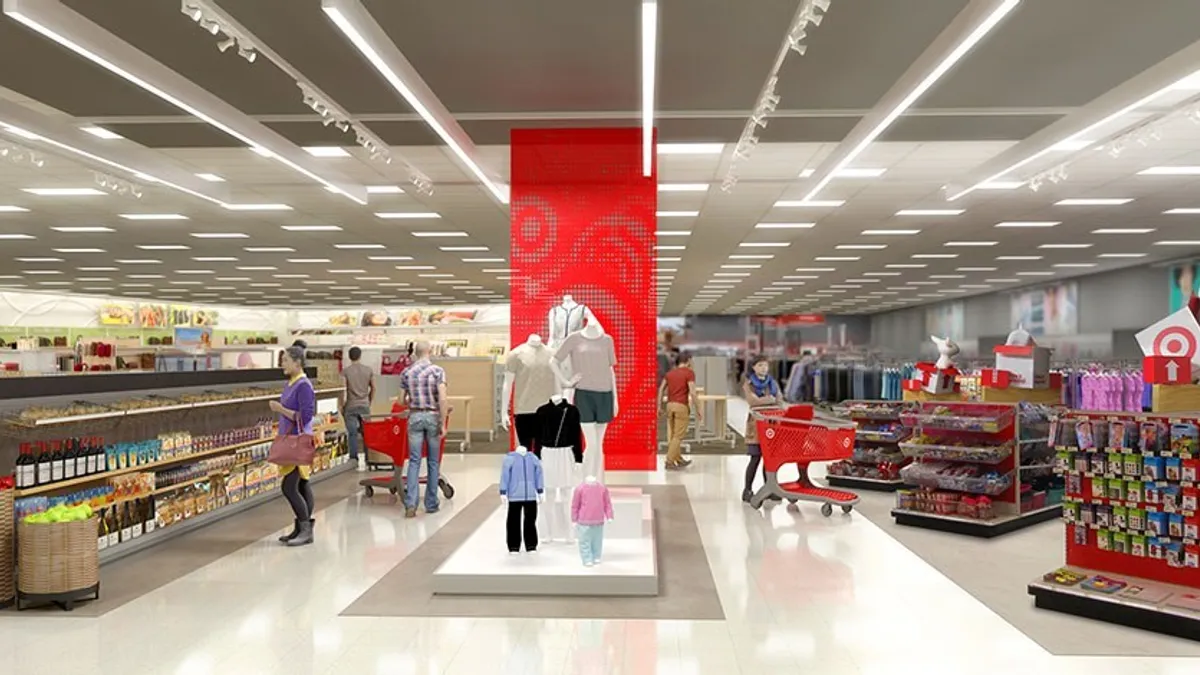Dive Brief:
-
Target is piloting new concepts in 25 stores in Los Angeles, spotlighting improvements including new lighting and displays, specialists to aid customers in departments like beauty, and dedicated stations supporting click-and-collect services, according to The Street.
-
Target's "LA25" concepts, which bring together under one roof store enhancements the retailer is testing in select locations across the U.S., also emphasize upgraded in-store dining options, replacing the chain's traditional popcorn and hot dog concessions with sleeker Starbucks cafes, Freshii salads and Which Wich deli sandwiches.
-
Target will spend $1 billion this year to overhaul the shopper experience: It will fully remodel 39 locations in 2016, and and open 15 new stores, The Street notes. Target selected Los Angeles for the pilot in part because California represents its biggest market, with 260 stores across the state, and because the area is home to a mix of big-box and smaller format stores,
Dive Insight:
Target took a hit this week with a Q1 report that included a muted outlook, the same week that Wal-Mart impressed investors with a sales beat.
But Target looks to be taking the long view. While Wal-Mart’s report this week made clear that it will trump any rival on price—a clear challenge to Amazon—Target is setting itself apart with differentiated merchandise and a more appealing store experience.
"What we are doing with LA25 will influence our next-generation store experience that we are working on—there may also be specific sections from these stores that may help influence the chain quicker," Mark Schindele, the Target senior vice president who's leading LA25, told The Street.
Decades ago, Target learned its lesson about competing on price when it tried to launch a price war with Wal-Mar, according to Mark Cohen, a professor of retail studies at Columbia University and an employee of Target’s parent company at the time. Target was blindsided by the extent to which Wal-Mart was willing to forego profits to win that war: In fact, Wal-Mart was willing to ship to other retail operations that found items priced lower than some wholesale prices. Target ultimately abandoned the effort, Cohen told Retail Dive in an interview last year.
In the aftermath, Target began collaborations with designers—it was an innovator of the now-ubiquitous retail effort—and fashioned its “cheap chic” approach that resonated with consumers and helped attract younger and wealthier shoppers. Target is now working to regain that reputation under CEO Brian Cornell.
“Target is just now getting its own mojo back after frittering it away over the last seven or so years, which is to say they were focused, importantly, on interesting, well-differentiated goods in addition to having the everyday things that people shop for every day,” Cohen told Retail Dive in a separate interview this year. “Wal-Mart has only been able to appeal by being cheap. Their stores don’t reflect any gracefulness or care in that regard. They’re just filled with stuff that’s priced very very cheaply.”
Target's first quarter same-store sales increased 1.2%, compared to analysts' expectations of 1.6%, according to research firm Consensus Metrix. Same-store web sales rose 23% in the quarter and the retailer found particular success with its style, baby, kids and wellness categories, which saw sales grow more than three times as much as the company average, Target said.













